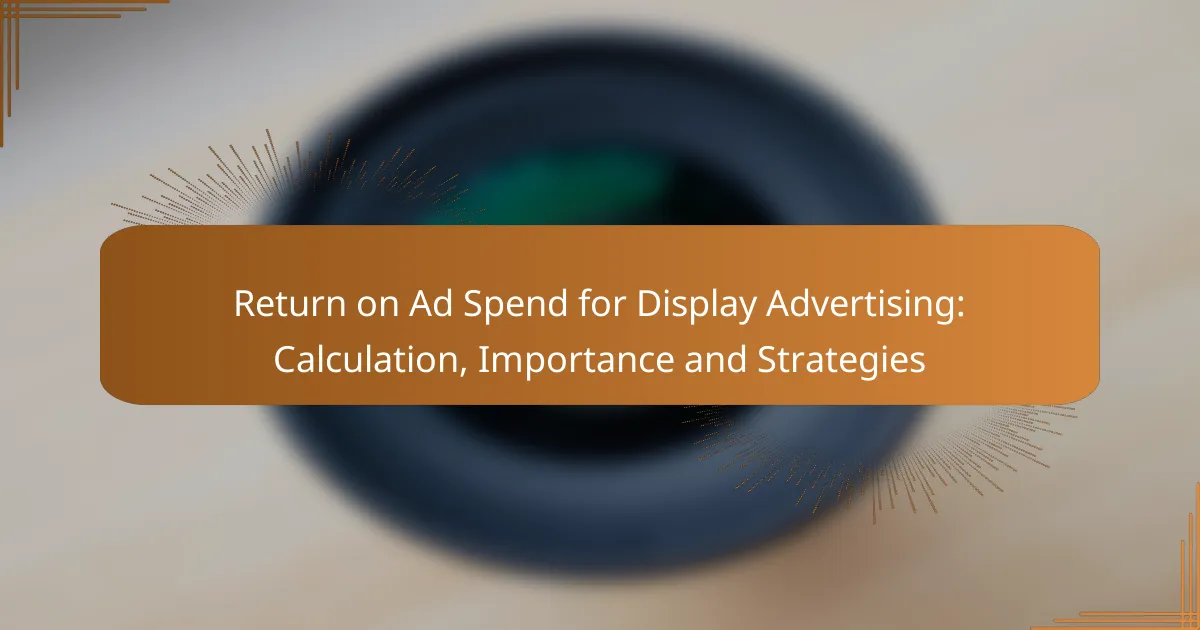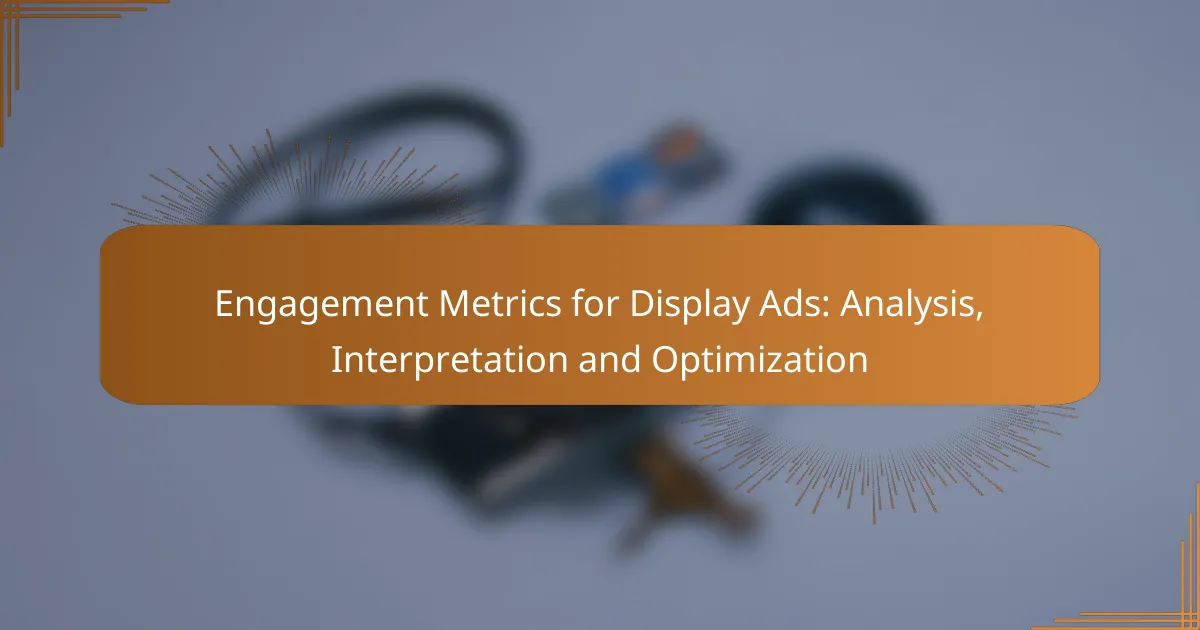Return on Ad Spend (ROAS) is a vital metric in display advertising, calculated by dividing the revenue generated from ads by the total ad expenditure. It provides insights into campaign effectiveness, enabling advertisers to optimize their budgets and enhance overall performance. By employing targeted strategies such as precise audience targeting and A/B testing, advertisers can significantly improve their ROAS and drive better results.

How to calculate Return on Ad Spend for display advertising?
Return on Ad Spend (ROAS) for display advertising is calculated by dividing the revenue generated from ads by the total cost of those ads. This metric helps advertisers understand the effectiveness of their campaigns and make informed decisions about future investments.
Formula for ROAS calculation
The formula for calculating ROAS is straightforward: ROAS = Revenue from Ads / Cost of Ads. For example, if a campaign generates $5,000 in revenue and costs $1,000, the ROAS would be 5, indicating that for every dollar spent, five dollars were earned.
It’s essential to ensure that both revenue and costs are measured over the same time period to maintain accuracy. This calculation can be applied to individual campaigns or aggregated across multiple campaigns for a broader view.
Key metrics for accurate calculation
To accurately calculate ROAS, consider key metrics such as total revenue, total ad spend, and conversion rates. Tracking these metrics helps in understanding the overall performance of display advertising campaigns.
Additionally, monitor metrics like click-through rates (CTR) and customer acquisition costs (CAC). High CTR with low CAC can indicate effective ad targeting, which can positively influence ROAS.
Examples of ROAS calculations
For a practical example, if a display ad campaign costs $2,000 and generates $10,000 in revenue, the ROAS would be calculated as follows: ROAS = $10,000 / $2,000 = 5. This means the campaign returned five times the investment.
Another scenario could involve multiple campaigns. If Campaign A costs $1,500 and generates $6,000, while Campaign B costs $500 and generates $2,000, the overall ROAS would be calculated by summing the revenues and costs: ROAS = ($6,000 + $2,000) / ($1,500 + $500) = $8,000 / $2,000 = 4. This indicates a solid return across both campaigns.

Why is Return on Ad Spend important for display advertising?
Return on Ad Spend (ROAS) is crucial for display advertising as it measures the revenue generated for every dollar spent on ads. Understanding ROAS helps advertisers optimize their budgets and improve overall campaign effectiveness.
Impact on advertising budget
ROAS directly influences how much of your advertising budget should be allocated to display ads. A higher ROAS indicates that your ads are performing well, allowing you to invest more in successful campaigns. Conversely, a low ROAS may signal the need to cut back on spending or reallocate funds to more effective channels.
For example, if your ROAS is 400%, it means you earn $4 for every $1 spent. This strong performance justifies a larger budget for display advertising, while a ROAS of 100% suggests that your spending is not yielding sufficient returns.
Influence on campaign strategy
Understanding ROAS helps shape your overall campaign strategy by identifying which ads and placements are most effective. By analyzing ROAS data, you can determine which audience segments respond best and tailor your messaging accordingly. This targeted approach can lead to improved engagement and conversion rates.
Additionally, tracking ROAS over time allows for continuous optimization. Regularly reviewing performance metrics can help you adjust your strategies, such as experimenting with different creatives or targeting options, to maximize returns. Always aim for a ROAS that meets or exceeds your business goals to ensure long-term success in display advertising.

What strategies improve Return on Ad Spend in display advertising?
Improving Return on Ad Spend (ROAS) in display advertising involves implementing targeted strategies that enhance ad effectiveness and efficiency. Key strategies include precise audience targeting, optimizing ad creatives, and utilizing A/B testing to refine campaigns.
Targeting the right audience
Effective audience targeting is crucial for maximizing ROAS in display advertising. By identifying and reaching the most relevant demographics, advertisers can ensure their messages resonate with potential customers, leading to higher engagement and conversion rates.
Consider using data analytics tools to segment your audience based on behavior, interests, and demographics. For example, targeting specific age groups or geographic locations can significantly improve ad performance, often resulting in a ROAS increase of 20-50%.
Optimizing ad creatives
Ad creatives must be visually appealing and relevant to the audience to drive conversions. High-quality images, compelling copy, and clear calls to action can significantly enhance user engagement and, consequently, ROAS.
Regularly refresh your ad creatives to avoid ad fatigue and maintain audience interest. Test different formats, such as static images, videos, or interactive ads, to determine which performs best. A/B testing can reveal that even small changes in design can lead to noticeable improvements in performance.
Utilizing A/B testing
A/B testing allows advertisers to compare different versions of ads to see which performs better. This strategy is essential for optimizing ROAS, as it provides data-driven insights into what resonates with your audience.
When conducting A/B tests, focus on one variable at a time, such as headlines, images, or calls to action. Aim for a sample size that allows for statistically significant results, and run tests for a sufficient duration to account for variability in user behavior. Regularly implementing A/B testing can lead to continuous improvement in ad performance and higher returns on your advertising spend.

What are the common challenges in achieving high Return on Ad Spend?
Achieving a high Return on Ad Spend (ROAS) can be hindered by several challenges that advertisers face. These challenges can significantly impact the effectiveness of display advertising campaigns and ultimately affect profitability.
Ad fraud issues
Ad fraud is a major challenge that can erode the effectiveness of display advertising. It includes practices such as click fraud, where automated bots generate false clicks, and impression fraud, where ads are displayed in non-viewable locations. These fraudulent activities can inflate advertising costs without delivering real value.
To combat ad fraud, advertisers should implement verification tools and partner with reputable ad networks that provide transparency. Regular audits of ad performance can help identify suspicious activity and ensure that budgets are being spent effectively.
Attribution difficulties
Attribution difficulties arise when it’s challenging to determine which ads or channels are driving conversions. This can lead to misallocation of budgets and an inaccurate understanding of campaign performance. Without clear attribution, optimizing ad spend becomes nearly impossible.
To improve attribution, consider using multi-touch attribution models that account for all interactions a customer has with your brand before converting. Tools like Google Analytics can help track user journeys and provide insights into which ads are most effective, allowing for better-informed decisions on budget allocation.

How does Return on Ad Spend vary across different industries?
Return on Ad Spend (ROAS) can significantly differ across industries due to varying customer behaviors, market dynamics, and advertising strategies. Understanding these variations helps businesses set realistic expectations and optimize their advertising budgets.
Comparison of ROAS in retail vs. services
In the retail sector, ROAS tends to be higher, often ranging from 400% to 800%, as consumers are typically ready to purchase immediately after seeing an ad. In contrast, service industries may experience lower ROAS, often between 200% and 500%, due to longer decision-making processes and the need for more customer education.
Retailers benefit from direct sales through online ads, while service providers often focus on lead generation, which may take longer to convert into revenue. This distinction influences how each sector measures and interprets their ROAS.
Industry-specific benchmarks
Benchmarks for ROAS vary widely by industry. For example, e-commerce businesses often aim for a ROAS of at least 400%, while travel and hospitality sectors may target around 300%. Understanding these benchmarks allows companies to gauge their performance against industry standards.
Other industries, like finance and education, may see ROAS benchmarks closer to 200% to 300%, reflecting the complexity of their offerings and customer acquisition costs. Regularly reviewing these benchmarks can help businesses adjust their strategies and improve their advertising effectiveness.

What tools can help track Return on Ad Spend?
Tracking Return on Ad Spend (ROAS) is essential for evaluating the effectiveness of display advertising. Several tools can assist marketers in measuring and optimizing their ad performance, ensuring that every dollar spent contributes to overall business goals.
Google Analytics for display ads
Google Analytics is a powerful tool for tracking ROAS from display ads. By linking your Google Ads account with Google Analytics, you can monitor user behavior after they click on your ads, providing insights into conversion rates and revenue generated. This integration allows for detailed reporting on metrics such as sessions, bounce rates, and goal completions.
To effectively use Google Analytics for ROAS tracking, set up specific goals that align with your business objectives. For example, if your goal is to increase sales, track transactions and revenue generated from display ad traffic. Regularly review these metrics to identify trends and optimize your campaigns accordingly.
Ad management platforms
Ad management platforms like AdRoll, Criteo, and Facebook Ads Manager offer robust features for tracking ROAS. These platforms provide comprehensive dashboards that display key performance indicators, including impressions, clicks, and conversions, making it easier to analyze the effectiveness of your display advertising efforts. They often include built-in attribution models to help you understand which ads are driving sales.
When using ad management platforms, take advantage of their reporting capabilities to compare different campaigns and ad sets. This can help you identify high-performing ads and allocate your budget more effectively. Additionally, consider A/B testing various ad creatives and targeting options to continuously improve your ROAS.

What are the future trends in Return on Ad Spend for display advertising?
Future trends in Return on Ad Spend (ROAS) for display advertising indicate a shift towards more data-driven strategies and personalized ad experiences. As technology evolves, advertisers will increasingly leverage advanced analytics and automation to optimize their campaigns and improve their returns.
Emerging technologies impact
Emerging technologies such as artificial intelligence (AI) and machine learning are significantly influencing ROAS in display advertising. These technologies enable advertisers to analyze vast amounts of data quickly, allowing for real-time adjustments to campaigns based on performance metrics. This can lead to more effective targeting and higher conversion rates.
Additionally, programmatic advertising is becoming more prevalent, automating the buying and selling of ad space. This method often results in better pricing and improved efficiency, which can enhance overall ROAS. Advertisers should consider integrating programmatic solutions to stay competitive.
Augmented reality (AR) and virtual reality (VR) are also gaining traction in display advertising. These immersive technologies can create engaging ad experiences that capture consumer attention, potentially leading to higher engagement rates and improved returns. Brands should explore innovative formats to leverage these technologies effectively.


